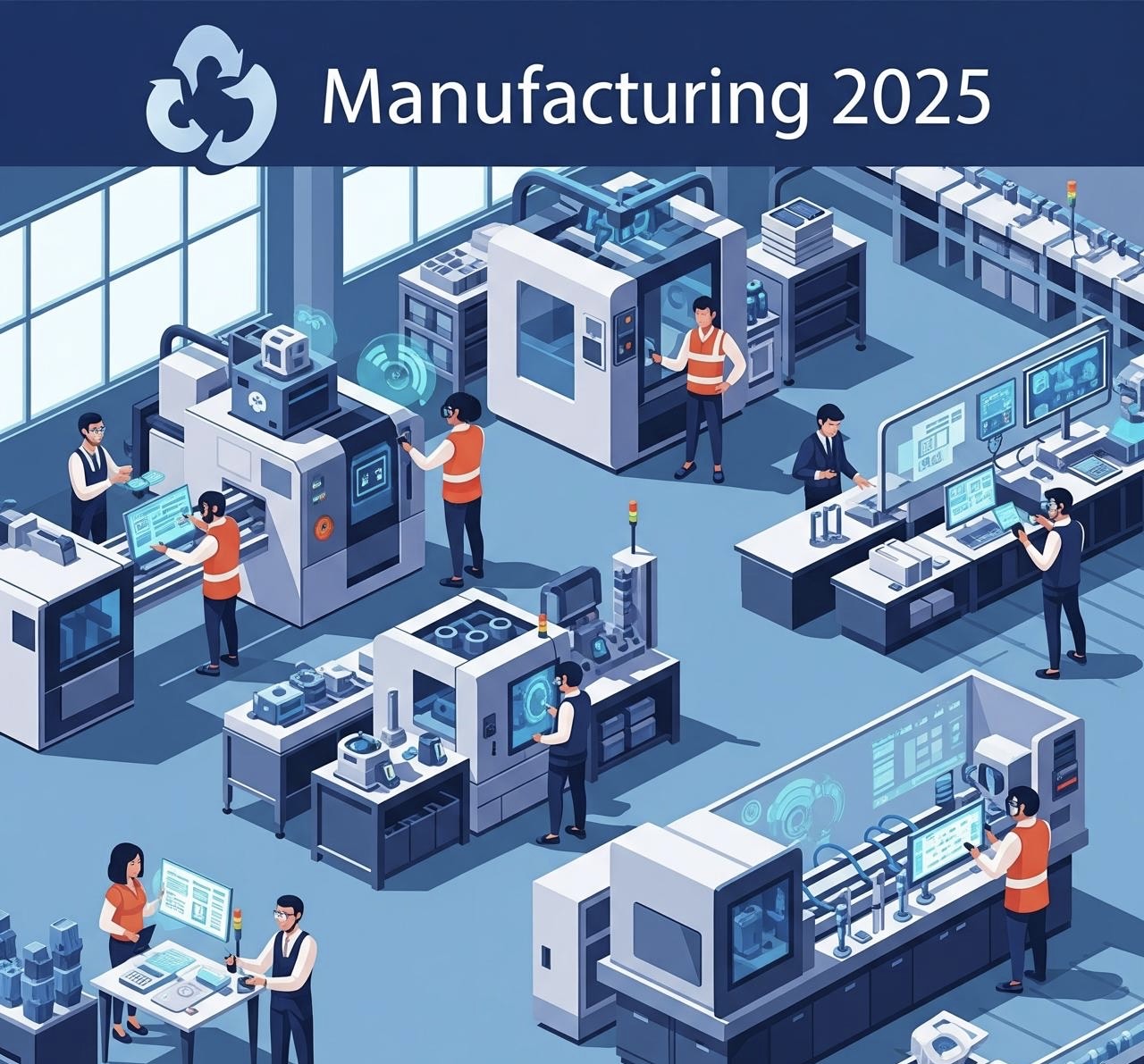
Top Trends in the Manufacturing Industry (2025)
Top Trends in the Manufacturing Industry (2025)
By: Destiny Dickerson
The manufacturing industry in 2025 is evolving at an unprecedented pace, shaped by innovation, global challenges, and a renewed emphasis on people and the planet. Gone are the days when production simply meant mass output from isolated assembly lines. Today, manufacturing is dynamic, tech-savvy, and mission-driven, where flexibility, sustainability, and talent development play just as important a role as machinery.
1. Collaborative Robots (Cobots)
One of the most noticeable shifts is the increasing use of collaborative robots, also known as cobots. These machines are designed to work directly with humans, not replace them. They assist with repetitive or physically demanding tasks, improving both efficiency and workplace safety. Companies like BMW and Ford are integrating cobots into their production lines to support tasks such as welding, packaging, and component assembly. Rather than separating humans from machines, the modern approach focuses on collaboration and leveraging shared strengths, enabling manufacturers to meet high demands without overworking their staff.
2. Sustainability and Circular Manufacturing
Sustainability has also become a core value in manufacturing, rather than just a marketing strategy. Circular manufacturing, which emphasizes waste reduction and the reuse of materials, is becoming the norm. Brands such as Patagonia are leading the charge by incorporating recycled materials into their products and encouraging customers to repair and reuse their gear instead of discarding it. This approach not only reduces environmental impact but also increases customer loyalty and aligns with global environmental goals. In the electronics sector, companies are designing phones and laptops with modular parts, allowing individual components to be repaired or replaced instead of discarding the entire device. As climate concerns rise, manufacturers that fail to embrace sustainable practices risk falling behind.
3. Reshoring and Regionalized Production
Another key development is the trend of reshoring, bringing manufacturing back home or closer to the end customer. The supply chain chaos of recent years, along with rising geopolitical tensions, has encouraged manufacturers to rethink their outsourcing strategies. Companies like General Motors and Intel are investing heavily in domestic production facilities to increase reliability and reduce transportation delays. Reshoring enables faster turnaround times, improved quality control, and stronger relationships with regional suppliers. This shift also reflects a growing desire to stimulate local economies and create jobs, particularly in regions that have been severely impacted by decades of offshoring.
4. Workforce Upskilling and Digital Training
As technology advances, the manufacturing workforce is transforming. It’s no longer just about manual labor; modern manufacturers need digitally literate employees who can operate high-tech equipment, interpret data, and solve problems quickly and efficiently. Companies like Amazon are investing billions into upskilling programs that teach workers how to use robotics, data systems, and AI-based tools. Some are even using virtual reality training simulations to prepare employees for real-life scenarios on the factory floor. This investment in people ensures that technological progress is matched with human capability, making the workforce a true asset in the digital age.
5. Green Energy Integration
In addition to workforce development, energy usage is being reimagined. With growing awareness around climate change, manufacturers are integrating renewable energy sources into their operations. Tesla’s Gigafactory is a prime example; it runs on solar energy and is working toward total energy self-sufficiency. Companies across industries are now installing solar panels, using wind turbines, and adopting energy-efficient lighting and machinery to reduce both emissions and costs. Energy management systems are being installed to monitor usage in real time and adjust consumption based on production needs. This shift not only satisfies environmental regulations but also appeals to eco-conscious consumers.
6. Agile and Custom Manufacturing
Manufacturers are also adopting more agile production models to meet the rising demand for customization. Today’s consumers want products that reflect their personal preferences, and manufacturers are responding by developing more flexible systems that enable small-batch, made-to-order production. Nike’s “Nike By You” platform enables customers to design their sneakers, which are then manufactured and shipped promptly. In the food industry, craft beverage companies and boutique brands are using small production runs to test seasonal flavors or limited-edition items. This level of agility gives manufacturers a competitive edge in a crowded market, allowing them to pivot quickly when trends shift.
7. Predictive Maintenance and AI Monitoring
Another transformative force in 2025 is the adoption of predictive maintenance powered by artificial intelligence. Instead of reacting to machine failures, companies now use sensors and AI to detect early warning signs of wear and tear. For instance, firms like Siemens and Caterpillar have adopted innovative maintenance systems that monitor equipment vibrations, temperature, and output. When something seems off, technicians are alerted before a breakdown occurs. This reduces downtime, extends machine life, and saves costs on emergency repairs. It’s a perfect example of how data-driven intelligence is making manufacturing more efficient and reliable.
Conclusion
Taken together, these trends indicate a manufacturing landscape that is smarter, greener, and more human-centered than ever before. Manufacturers that embrace change, not just in technology, but in mindset, are redefining what it means to build something in the modern world. Success now depends on collaboration between machines and people, a deep respect for the planet, and a commitment to adaptability. The factories of 2025 are no longer just about output; they are engines of innovation, sustainability, and progress.
Sources
- Deloitte. (2024). 2024 Manufacturing Industry Outlook. Retrieved from: https://www2.deloitte.com/us/en/pages/manufacturing/articles/manufacturing-industry-outlook.html
- McKinsey & Company. (2024). The Future of Manufacturing: Technology Trends to Watch. Retrieved from: https://www.mckinsey.com/business-functions/operations/our-insights/the-future-of-manufacturing
- World Economic Forum. (2023). Circular Economy in Manufacturing. Retrieved from: https://www.weforum.org/agenda/2023/06/circular-manufacturing-models
Forbes. (2024). The Return of Reshoring in U.S. Manufacturing. Retrieved from: https://www.forbes.com/sites/forbestechcouncil/2024/03/12/reshoring-manufacturing-in-2025 - International Federation of Robotics. (2023). Cobots in the Manufacturing Sector. Retrieved from: https://ifr.org/worldrobotics
- Amazon. (2022). Upskilling 2025 Pledge. Retrieved from: https://www.aboutamazon.com/news/workplace/upskilling-2025-amazons-1-2-billion-commitment-to-employees